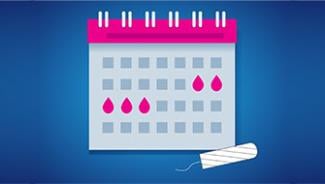Period cravings: What do they mean?

You know the drill: Three spoonfuls into the peanut butter container you think, What am I doing? And then you realize the date. Your period is due in about a week.
You are likely familiar with cravings before periods, including chocolate, carbohydrates, sweets, salty foods and more. Here we discuss why you might crave these foods and what your specific cravings may indicate. We’ll also share some foods that could possibly help reduce premenstrual syndrome (PMS) symptoms.
In this article
Common period cravings
According to the Office on Women’s Health, more than 90% of women say they get some PMS symptoms, including cramps, headaches, bloating and food cravings.1 Changing hormone levels throughout the menstrual cycle may be why some folks experience PMS.1
Craving chocolate during your period
According to a 2014 paper published in Frontiers in Psychology, women in the U.S. are twice as likely to crave chocolate compared to men, which is likely due to menstruation.2 Women tend to crave chocolate more intensely and more frequently about four days prior to the onset of their period.2 Researchers have studied whether hormone fluctuations, nutritional deficits, certain ingredients in chocolate and/or cultural and psychological factors play a role in craving chocolate, but there is little evidence to prove that chocolate cravings are a result of physiological or biomedical causes.2
Interestingly, a 2017 PLoS One study looked at food cravings as a culture-bound construct, pointing out that most languages don’t have an English equivalent for the word “craving.”3 Women of diverse backgrounds reported on their cravings and those born outside the U.S. were significantly less likely to crave chocolate.3 The study suggests simply living in the U.S. increases the likelihood that you will blame (or thank!) your period for your, perhaps perceived, chocolate cravings.3
Craving pizza during your period
Many folks crave carbs in the days prior to and while on their period, which may be why your local pizza parlor can almost predict when you will make your next midnight order. This may be due to some people having a serotonin deficiency that could contribute to PMS symptoms.4 (Some folks are prescribed selective serotonin reuptake inhibitors – SSRIs – by their healthcare providers to relieve symptoms of PMS.)4
Serotonin, a hormone that is produced in the center of the brainstem, can boost your mood.5 Foods rich in carbohydrates, such as pizza, increase serotonin levels in the brain,6 but not directly. According to Harvard Health, eating carbs helps your body produce insulin, which in turn gives tryptophan (the amino acid your brain uses to make serotonin) a better chance of reaching your brain. More nutritious carbohydrate options to grab throughout the day include complex carbs (think whole grains, legumes, vegetables and fruits).5
Craving sodium during your period
Craving salt specifically during your period is fairly uncommon. What you’re likely craving is whatever the salt is on — a French fry, pretzel, potato chip or other snack-like food. And that craving could be due to craving carbs, or a serotonin deficiency, which we talked about above. Another reason? You could be thirsty. Thirst changes are a symptom of PMS7 and some people crave salt when they’re dehydrated.
Craving orange juice during your period
A 2017 study in Obstetrics & Gynecology Science showed the positive effect of calcium on PMS.8 Calcium can be found in many foods, such as milk, yogurt and cheese.1 Many foods also have calcium added.1 These include bread, cereal and orange juice.1 (Just look for the word “fortified” on your favorite brand of OJ.) If you’re craving orange juice, this may be your body’s way of remembering how calcium benefited you the last time you had PMS.
Craving sugar during your period
If you’ve been craving carb-rich sweets or sodas in the days leading up to your period or during your period, your hormones could be one of the reasons. There’s evidence to suggest that those who happen to have higher levels of certain hormones during the luteal phase (after ovulation during the menstrual cycle) may be more likely to seek out sweets. A 2016 study in The FASEB Journal showed that during the luteal phase women with higher levels of estradiol (estrogen) reported an increase in carbohydrate and sweet-food cravings, and those with higher progesterone levels reported a slightly increased consumption of sweet drinks.9
Foods that may reduce PMS symptoms
According to the Office on Women’s Health, certain vitamins and minerals may relieve some PMS symptoms.1 You should always talk to your healthcare provider before taking a new supplement. That said, a lot of vitamins and minerals can be found in food you eat throughout the course of the day.
The Office on Women’s Health says studies have identified PMS relief benefits for the following:
- Calcium (to help with fatigue, cravings and depression): milk, cheese, yogurt, and in fortified foods such as orange juice, cereal and bread.1
- Vitamin B6 (to help with irritability, moodiness, forgetfulness, anxiety and bloating): fish, poultry, potatoes, fruit (not citrus), and in fortified foods, such as cereal.1
The Office on Women’s Health also says studies have found mixed results for PMS relief for the following:
- Magnesium (to help with migraines): green, leafy vegetables, nuts, whole grains and fortified foods such as cereal.1
- Polyunsaturated fatty acids, omega-3 and omega-6 (to help reduce cramps): green leafy vegetables, fish, nuts and flaxseed.1
The American College of Obstetricians and Gynecologists says a diet rich in complex carbohydrates may help with moodiness and cravings. Examples include whole wheat bread, pasta and cereal, brown rice, barley, beans and lentils.7
No matter what you do – or don’t – eat on the days leading up to and during your period, give yourself some grace. Your body does some pretty remarkable things each menstrual cycle, and PMS is often no joke. There are a lot of healthy ways to try to relieve PMS symptoms. Exercise, getting plenty of sleep, eating healthy foods, finding positive ways to deal with stress and not smoking can all be beneficial.1 But balance is also key. On a particularly crampy or teary day, sometimes the best way of loving yourself is in the form of a scoop of ice cream or a delicious savory treat.
Sources
- “Premenstrual syndrome (PMS),” (February 22, 2021), Office on Women’s Health, U.S. Department of Health & Human Services, https://www.womenshealth.gov/menstrual-cycle/premenstrual-syndrome
- Orloff, N.C., Hormes, J.M., “Pickles and ice cream! Food cravings in pregnancy: hypothesis, preliminary evidence, and directions for future research,” (September 23, 2014), Frontiers in Psychology, 5, https://www.frontiersin.org/articles/10.3389/fpsyg.2014.01076/full#h6
- Hormes, J.M., Niemiec, M.A., “Does culture create craving? Evidence from the case of menstrual chocolate craving,” (July 19, 2017), PLoS One, 12(7), https://journals.plos.org/plosone/article?id=10.1371/journal.pone.0181445
- Pinkerton, J.V., “Premenstrual Syndrome (PMS),” (December 2020), Merck Manual Professional Version, https://www.merckmanuals.com/professional/gynecology-and-obstetrics/menstrual-abnormalities/premenstrual-syndrome-pms
- Watson, Stephanie, “Serotonin: The natural mood booster,” (July 20, 2021), https://www.health.harvard.edu/mind-and-mood/serotonin-the-natural-mood-booster
- Wurtman, R.J., Wurtman, J.J., Regan, M.M., McDermott, J.M., Tsay, R.H., Breu, J.J., “Effects of normal meals rich in carbohydrates or proteins on plasma tryptophan and tyrosine ratios,” (January 2003), The American Journal of Clinical Nutrition, 77(1), 128–132, https://doi.org/10.1093/ajcn/77.1.128
- “Premenstrual Syndrome (PMS),” (May 2021), The American College of Obstetricians and Gynecologists, https://www.acog.org/womens-health/faqs/premenstrual-syndrome
- Shobeiri, F., Araste, F.E., Ebrahimi, R., Jenabi, E., & Nazari, M., “Effect of calcium on premenstrual syndrome: A double-blind randomized clinical trial,” (January 15, 2017), Obstetrics & Gynecology Science, 60(1), 100–105, https://www.ncbi.nlm.nih.gov/pmc/articles/PMC5313351/
- Krishnan, S., Tryon, R., Welch, L.C., Horn, W.F., Keim, N.L., “Menstrual cycle hormones, food intake, and cravings,” (April 1, 2016), The FASEB Journal, 30(51), https://faseb.onlinelibrary.wiley.com/doi/abs/10.1096/fasebj.30.1_supplement.418.6

All you need to know about your period
Even if you get your period every month, how much do you really know about periods?




